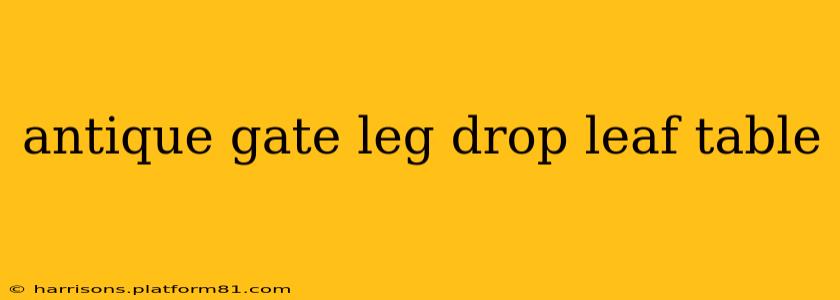The antique gate leg drop leaf table holds a special place in the hearts of furniture enthusiasts. Its ingenious design, historical significance, and undeniable charm make it a coveted piece for collectors and antique lovers alike. This guide delves into the fascinating world of these tables, exploring their history, identifying key characteristics, and providing valuable insights for discerning collectors.
What is a Gate Leg Drop Leaf Table?
A gate leg drop leaf table is a type of folding table characterized by its unique support system. Instead of traditional legs, it utilizes "gate legs" – hinged supports that fold out from the table's apron, providing stability when the drop leaves are extended. These leaves, typically hinged to the table's sides, can be raised and lowered, expanding the table's surface area as needed. This clever design allowed for compact storage when not in use, making it a highly practical and space-saving piece of furniture for centuries.
What are the Different Types of Antique Gate Leg Drop Leaf Tables?
The design of gate leg drop leaf tables evolved over time, resulting in a diverse range of styles and variations. Some key distinctions include:
- Period Styles: These tables reflect the prevailing design aesthetics of their era, such as the simple elegance of Queen Anne, the ornate carvings of the Victorian period, or the clean lines of the Georgian era. The wood type, joinery, and overall aesthetic heavily influence the table's identification and value.
- Size and Shape: Tables varied significantly in size, from small occasional tables suitable for a single person to larger dining tables capable of seating multiple guests. Some boasted rectangular tops, while others featured more unusual shapes.
- Materials: While hardwoods like oak, walnut, mahogany, and cherry were commonly used, the choice of wood varied depending on availability and cost. The quality and condition of the wood are critical factors in determining a table's worth.
How Can I Identify an Antique Gate Leg Drop Leaf Table?
Authenticating an antique gate leg drop leaf table requires careful examination of several key features:
- Construction: Look closely at the joinery, paying attention to the type of wood joints used. Dovetail joints, mortise and tenon joints, and other traditional joinery techniques indicate higher quality and craftsmanship, often associated with earlier pieces.
- Hardware: The hinges, brackets, and other metalwork can offer clues to the table's age and origin. Examine the style, material, and construction of the hardware. Original hardware is highly desirable.
- Wood: Identify the type of wood used. The wood's grain, color, and condition can indicate age and quality. Examine for signs of age, such as patina and wear.
- Style and Design: Consider the overall style and design elements, comparing them to known period styles. Research different eras and styles to refine your identification.
What is the Value of an Antique Gate Leg Drop Leaf Table?
The value of an antique gate leg drop leaf table is highly variable and depends on several factors:
- Age and Origin: Older tables, especially those with documented provenance, tend to command higher prices.
- Condition: A table in excellent condition with minimal damage will fetch a much higher price than a heavily damaged or restored piece.
- Rarity: Unusual styles, materials, or features can increase a table's value.
- Demand: Current market trends and collector interest influence prices. Rarity and desirability are key components.
How Do I Care for My Antique Gate Leg Drop Leaf Table?
Proper care is crucial for preserving the beauty and value of your antique gate leg drop leaf table:
- Cleaning: Use gentle cleaning methods, avoiding harsh chemicals or abrasive cleaners. A soft cloth and mild furniture polish are usually sufficient.
- Storage: Store the table in a climate-controlled environment, away from direct sunlight and extreme temperatures or humidity.
- Protection: Use coasters and placemats to protect the surface from scratches and spills.
- Repair: Only use qualified and experienced antique furniture restorers for repairs.
What are Common Problems with Antique Gate Leg Drop Leaf Tables?
Over time, antique gate leg drop leaf tables can suffer from various issues:
- Loose Joints: Wear and tear can loosen joints, requiring repair or tightening.
- Damaged Wood: Scratches, dents, and other damage can occur over time.
- Worn Hardware: Hinges, brackets, and other metal components may become worn or broken.
- Loose Leaves: Drop leaves may become loose or difficult to raise and lower.
Addressing these problems promptly with professional restoration can help preserve the table's condition and value.
Where Can I Find Antique Gate Leg Drop Leaf Tables?
Antique gate leg drop leaf tables can be found in a variety of places:
- Antique shops and malls: These are excellent resources for finding a wide variety of antique furniture.
- Auction houses: Auctions often feature rare and valuable antique furniture.
- Online marketplaces: Websites specializing in antiques and collectibles offer a vast selection of tables.
- Estate sales: Estate sales can be a great source for uncovering hidden treasures.
By carefully considering these factors and conducting thorough research, you can successfully navigate the world of antique gate leg drop leaf tables, appreciating their history, identifying authentic pieces, and potentially adding a valuable and beautiful item to your collection.
